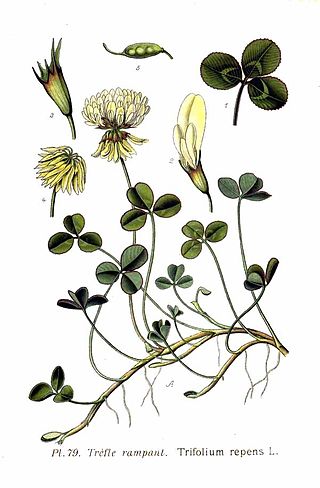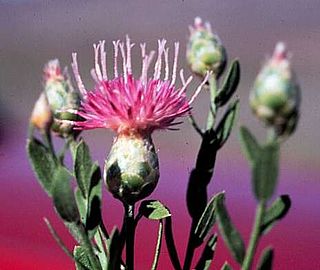
Clover or trefoil are common names for plants of the genus Trifolium, consisting of about 300 species of flowering plants in the legume or pea family Fabaceae originating in Europe. The genus has a cosmopolitan distribution with highest diversity in the temperate Northern Hemisphere, but many species also occur in South America and Africa, including at high altitudes on mountains in the tropics. They are small annual, biennial, or short-lived perennial herbaceous plants, typically growing up to 30 centimetres (12 in) tall. The leaves are trifoliate, monofoliate, bifoliolate, quinquefoliolate, hexafoliolate, septafoliolate, etcetera, with stipules adnate to the leaf-stalk, and heads or dense spikes of small red, purple, white, or yellow flowers; the small, few-seeded pods are enclosed in the calyx. Other closely related genera often called clovers include Melilotus and Medicago.

Leuzea repens, synonyms including Acroptilon repens and Rhaponticum repens, with the common name Russian knapweed, is a bushy rhizomatous perennial, up to 80 cm tall. Stems and leaves are finely arachnoid-tomentose becoming glabrous and green with age. The rosette leaves are oblanceolate, pinnately lobed to entire, 2–3 cm wide by 3–8 cm long. The lower cauline leaves are smaller, pinnately lobed; the upper leaves become much reduced, sessile, serrate to entire. The heads are numerous terminating the branches. Flowers are pink to purplish, the marginal ones not enlarged. The outer and middle involucral bracts are broad, striate, smooth with broadly rounded tips; the inner bracts are narrower with hairy tips. Pappus present with bristles 6–11 mm long. Fruit is a whitish, slightly ridged achene.

Trifolium repens, the white clover, is a herbaceous perennial plant in the bean family Fabaceae. It is native to Europe, including the British Isles, and central Asia and is one of the most widely cultivated types of clover. It has been widely introduced worldwide as a forage crop, and is now also common in most grassy areas of North America, Australia and New Zealand. The species includes varieties often classed as small, intermediate and large, according to height, which reflects petiole length. The term 'white clover' is applied to the species in general, 'Dutch clover' is often applied to intermediate varieties, and 'ladino clover' is applied to large varieties.

Serenoa repens, commonly known as saw palmetto, is a small palm, growing to a maximum height around 7–10 ft (2.1–3.0 m).

The four-leaf clover is a rare variation of the common three-leaf clover. According to traditional sayings, such clovers bring good luck, though it is not clear when or how this idea began. One early mention of "Fower-leafed or purple grasse" is from 1640 and simply says that it was kept in gardens because it was "good for the purples in children or others".

Ranunculus repens, the creeping buttercup, is a flowering plant in the buttercup family Ranunculaceae, native to Europe, Asia and northwestern Africa. It is also called creeping crowfoot and sitfast.

Elymus repens, commonly known as couch grass, is a very common perennial species of grass native to most of Europe, Asia, the Arctic biome, and northwest Africa. It has been brought into other mild northern climates for forage or erosion control, but is often considered a weed.

Goodyera repens, an orchid in the genus Goodyera, is called by the common name creeping lady's-tresses in Anglophone Europe and dwarf rattlesnake plantain or lesser rattlesnake plantain in North America.

Staurogyne is a genus of plants in the family Acanthaceae.
Saw palmetto extract is an extract of the fruit of the saw palmetto. It is marketed as a dietary supplement that may help with benign prostatic hyperplasia, but there is no clinical evidence that it is effective for this purpose.

Ononis repens, the common restharrow, is a flowering plant species in the bean family Fabaceae. The name is synonym of Ononis spinosa subsp. procurrens.
Staurogyne bicolor is a species of plant in the family Acanthaceae. It is endemic to Cameroon. Its natural habitat is subtropical or tropical moist lowland forests. It is threatened by habitat loss.
Staurogyne sichuanica is a species of plant in the family Acanthaceae. It is endemic to China.

Procris repens is a species of flowering plant in the nettle family, Urticaceae, commonly known as the watermelon begonia or sisik naga, although the latter name may also refer various Pyrrosia species.

Coprosma repens is a species of flowering shrub or small tree of the genus Coprosma, in the family Rubiaceae, native to New Zealand. Common names include taupata, tree bedstraw, mirror bush, looking-glass bush, New Zealand laurel and shiny leaf.

Dichondra repens, commonly known as kidney weed, Mercury Bay weed, tom thumb, or yilibili in the Dharawal language, is a species of flowering plant in the family Convolvulaceae and is native to Australia, New Zealand, and the Indian Ocean islands, Mauritius, Réunion and Rodrigues. It is a perennial, herb with kidney-shaped to round leaves and small, greenish-yellow, star-shaped flowers.
Koehneola is a monotypic genus of flowering plants in the daisy family. There is only one known species, Koehneola repens.

Salix repens, the creeping willow, is a small, shrubby species of willow in the family Salicaceae, growing up to 1.5 metres in height. Found amongst sand dunes and heathlands, it is a polymorphic species, with a wide range of variants. In the UK, at least, these range from small, prostrate, hairless plants at one end of the spectrum to taller, erect or ascending silky-leaved shrubs at the other. This wide variation in form has resulted in numerous synonyms.

Veronica repens, the Corsican speedwell or creeping speedwell, is a species of flowering plant in the family Plantaginaceae, native to Corsica and Morocco. The 'Sunshine' cultivar, whose tiny flowers are purple instead of the usual white, is recommended for rock gardens and as a ground cover.














